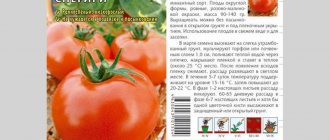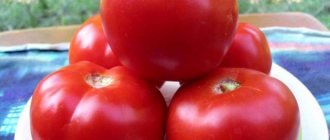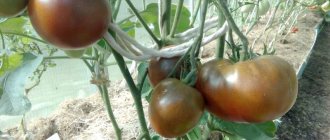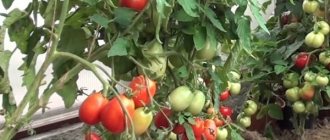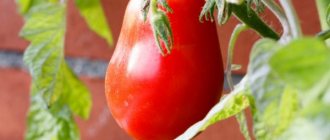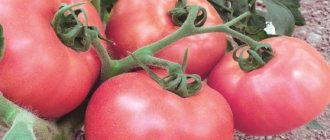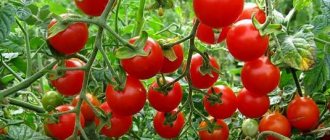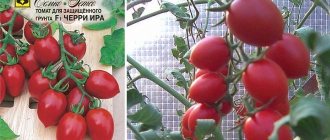Description of the variety
Caramel tomatoes are a hybrid developed by breeders. In hybrids they try to combine the strengths of different varieties. For example, in Caramel it is resistance to disease and bad weather. Also, the variety is loved by many because of its high yield and excellent taste. Detailed characteristics and description are presented below.
Subspecies Caramel red
Red Caramel tomato bushes are neat and serve as a real decoration for the garden. However, they reach a height of 2 m, so gartering and pinching are required.
There are many leaves, they are very dense and dark green in color. The tomatoes are small, deep scarlet in color. The aroma is classic, sweetish.
Tomatoes ripen in clusters, 40-50 pieces each. The pulp is very juicy, with a high content of vitamins B and C.
They are grown both under film and in the open air. Well stored and transported.
Subspecies Caramel yellow
Yellow caramel ripens early, approximately 90 days from planting. Tomatoes resemble plums and have a pleasant yellow tint. From 1 square meter, gardeners harvest about 4 kg of ripe tomatoes. The variety is great for whole canning and preparing various dishes.
Experienced gardeners grow the variety exclusively in greenhouses and greenhouses. The plant is sensitive to soil, so you need to regularly feed the bushes. In addition, the variety must be tied up and bushes formed.
Distinctive features
The Caramel variety is characterized as indeterminate, reaching a height of about 2.3 m. The stem is powerful and long. The plant is not afraid of a long absence of sun or spring frosts. Even an inexperienced gardener can get a rich harvest of Caramel.
Characteristics of tomatoes, yield
Tomatoes reach a maximum diameter of 3 cm, the average weight of one is about 30-35 g. The color is even, rich red. The skin is dense and smooth. The shape is round, slightly elongated. The taste is juicy and rich.
Yellow tomatoes for the middle zone
Thanks to selection, the range of yellow-fruited varieties has expanded significantly. It is easy to find varieties and hybrid forms for cultivation in different climatic zones. There are especially many options offered for gardeners in the central regions of the country.
Ray
Summer residents have been growing the Luch tomato variety for almost two decades, noting its unpretentiousness and productivity. Among the “advantages”: the sweetness of the fruit, so elongated tomatoes with a “spout” are used not only for preparations, but also for salads.
The plant belongs to the group of determinate species, with a height of up to 90-100 cm. Usually in the regions of the central zone of the Russian Federation it is grown directly in the beds. The harvest can be harvested after 110 days, but the fruits will still be green. It will take approximately 135 days to fully ripen.
Tomatoes have an interesting shape: elongated, about 7-9 cm long, yellow. By weight - 50-70 grams, therefore suitable for pickles and marinades. The variety is resistant to late blight, powdery mildew, and rot.
On a note!
Lucha fruits can be stored for up to 3-4 months when favorable conditions are created.
Disadvantage: low yield. Up to 2 kg of “rays” are removed from the bush, but the small number is compensated by the excellent sweet taste.
Honey saved
The bush grows up to one and a half meters, so, at first glance, the variety is suitable only for greenhouse cultivation. But Honey Spas grows well in the open air, forming fruits with high sugar content.
The tomato is tasty, juicy, meaty. Summer residents note that in greenhouses the fruits do not have the same taste as when grown in beds. Kidney-shaped tomatoes weighing approximately 280-300 grams ripen on the branches. The variety is recommended for the diet menu.
Yellow giant
The authorship of the selection belongs to agro. Salad-type fruits are characterized by a high content of beta-carotene and sugars.
The variety is recommended for planting in shelters. In terms of time - 118-122 days, ripens together. The fruits are slightly flattened, weigh from 300 to 400 grams, and are yellow in color.
Yellow giant tomatoes are not suitable for storage; they also do not tolerate transportation well, losing their presentation. The variety is distinguished by an extended period of fruit production.
Heart of Ashgabat
The tomato with the beautiful name Heart of Ashgabat will reward you with delicious and very sweet fruits. With proper care, it produces up to 4-4.2 kg of tomatoes per bush.
Semi-determinate variety, distinguished by fruits without acid. Contains a high sugar content. Thanks to these parameters, it is recommended for nutrition for people on a certain diet and who have restrictions on the consumption of certain foods.
Disease-resistant tomato that does not require special care. Needs shaping of the bush, removal of stepsons.
Yellow scallops
In the south it grows without shelter, in the north it grows only in greenhouses. Tall indet produces large, sweet fruits weighing 300-400 grams. The tomatoes are heart-shaped, juicy, and do not crack. The color of the fruit is interesting: yellow with graining, sometimes there may be pinkish veins.
This variety of tomatoes is recommended for dietary nutrition and preparing children's menus.
Honey drop
A variety from the group of tall plants, suitable for cultivation in shelters. In the middle zone, they are planted in greenhouses and grow to 1.5-2 meters in height.
The fruits are small, original in shape in the form of “pears” or “droplets”, rich yellow in color. Tasty, juicy, with characteristic honey tones. The formation is carpal, according to the number of tomatoes - 20-30 pieces. Main use: to eat fresh (like candy), for preservation, for decorating culinary dishes.
Yellow date
The tomato is so called because of its resemblance to the fruits of a real date. The tomatoes are sweet and have a pleasant aroma. The shape resembles “cream”, the skin is glossy and dense.
The “plus” of the variety is its excellent transportability, which is why it is grown for sale. In terms of timing, the tomato is a medium-late tomato; it begins to yield closer to August, so planting is only in greenhouses.
The plants are tall, up to 1.5 meters, and require regular care and shaping. Features of the variety: low foliage, frequent arrangement of clusters on the branches, high fruit set.
Preparing seedlings
Growing in seedlings will help the plant to sprout faster and better adapt to climatic conditions. Therefore, it is important to comply with all necessary requirements when preparing seedlings.
Seed preparation
Since Caramel is a hybrid, the seeds are purchased only in stores. The bag contains all the information about the manufacturer, as well as planting tips. First of all, pay attention to seed treatment. Some gardeners claim that the seeds of hybrids are already pre-treated with disinfectants.
However, it would not be a bad idea to carry out the operation again yourself. For this we use a solution of hydrogen peroxide:
- take a 3% solution and heat it to a temperature of 40 degrees;
- place the seeds in a fabric bag;
- lower it into the solution for 10 minutes;
- remove and pour the seeds onto a napkin;
- leave on a napkin until completely dry.
Important! In addition to processing, the seeds need to be coated. This saturates the young shoots with nutrients and vitamins. We recommend the Zircon solution - soak the seed in it for 3 hours. It increases germination and develops disease resistance.
Container and soil
The best soil for seedlings is a mixture of garden soil, humus and vermiculite. The latter is a natural material that performs a number of important functions:
- makes the soil more loose and water-retentive (for the greatest effect, manure or grass is added to it);
- sprouts develop faster, while vermiculite strengthens their root system;
- reduces the risk of developing fungal infections;
- saturates sprouts with magnesium, calcium and iron.
Important! Before planting seedlings, add 3-4 tablespoons of vermiculite to each hole.
As for containers for seedlings, any clean and dry boxes, crates, or pots will do. If you don’t have such containers at home, you can always find special cassettes or containers in a gardening store.
Sowing
Seeds are planted for seedlings 2 months before the intended planting in the ground. Soil is poured into the prepared container, holes are made in it using a small cutting, seeds are placed in them and soil is sprinkled on top.
The sprouts should be 10-15 cm apart from each other. It is better to cover the top of the container with seedlings with cling film, after thoroughly watering the seedlings with warm water.
Growing and care
Place the sprouts in a warm, well-lit place. Seedlings love warmth and sun, so choose the brightest place in your home. The first watering is after 7-10 days. Under no circumstances should you water the seedlings with cold tap water, as this may cause the hybrid to become infected with germs. As soon as the first shoots appear, remove the film. Try to avoid drafts - this is harmful to the seedlings.
After 20 days, we recommend organizing the first feeding. A solution with bird droppings is suitable for this. Do subsequent fertilizing until the plant is planted on the site. Also, do not forget about hardening off the seedlings. Take the containers out onto the balcony, increasing the time it stays every day. The procedure will help the plant quickly get used to climatic conditions.
Growing rules
Even a novice gardener can grow tomatoes of this variety. Planting is carried out using the seedling method. Sowing seeds in containers to obtain seedlings begins in the third decade of March. You can do without disinfection measures, but you will have to treat the seed with a growth stimulant, which will increase the yield.
Soil consisting of garden soil with the addition of humus and vermiculite is placed in containers for sowing seeds. The seeds are placed in shallow furrows and sprinkled with soil on top.
Immediately after sowing, the soil in the container is watered generously and covered with plastic wrap. During this period, the main condition for normal seed germination is a room with a temperature of about +23 degrees.
After the sprouts appear, the containers are moved to a cooler place, well lit by sunlight.
Picking
Picking up tomato seedlings after the formation of two true leaves is of no small importance. Each seedling is placed in a separate container or in one container, but with a large distance between plants. Planting in a greenhouse or open ground is carried out in the second half of May. It is necessary to make sure that the soil is sufficiently warmed up and that there is no danger of a recurrence of frost.
Planting is carried out in this way: per 1 sq. m there should be no more than 3 tomato bushes of this variety. A handful of wood ash and a spoonful of complex mineral fertilizer are poured into each hole. After replanting, be sure to thoroughly water the soil with the seedlings.
Stepsoning
As it grows, stems that do not have an ovary are pinched. It is advisable to leave 1 - 2 large stems on the bush. To stop the growth of the plant in height, the top point of the bush is pinched, which provides access to the crown of sunlight, which has a beneficial effect on the formation of ovaries and the ripening of fruits.
To prevent the stems from breaking, periodic inspection of the bushes is carried out in order to timely tie them to supports or to a trellis.
Watering
Watering is of no small importance. Irrigation is carried out with warm water. If there is a well or well on the site, water is first collected in a large container, and after it is warmed up, watering is carried out. This procedure is carried out in the evening so that the water that gets on the leaves after heating it by the sun’s rays does not burn the leaves. Optimally, watering should be carried out at the root of the plant.
How to grow tomatoes
Caramel is planted in mid-May. Gardeners from the southern regions boldly place the variety in open ground, and gardeners from central Russia are recommended to plant the tomato in a greenhouse or hothouse.
Landing
The land for planting is prepared in the fall. It is dug up, cleaned of weeds and previous plants. The best predecessors of Caramel are bell peppers, carrots, and zucchini. Avoid planting potatoes in beds. In the spring they are dug up again and all the garbage is burned. It would be a good idea to water the soil with a solution of potassium permanganate - this will destroy larvae and dangerous microorganisms.
Bushes are planted at a distance of 40-50 cm from each other. After planting, the beds are watered with warm water. Make sure that it does not get on the leaves and stem, otherwise there is a high risk of developing fungi and viruses. When planting, do not allow the sprouts to break and be careful.
Care
First of all, follow the watering schedule. Do not allow the soil to become waterlogged, otherwise the tomatoes may crack or, even worse, get sick. It is better to water them in the evening or in the morning. For prevention purposes, you can add milk or whey to the water. The solution will not only moisturize, but will also have a preventive effect against diseases and parasitic insects.
The beds need regular loosening. This gives the bushes more oxygen. Also, do not allow the garden to become overgrown with weeds. Weeds take nutrients from tomatoes.
Due to their high growth, the bushes need shaping. Tie them to wooden stakes - they also need to be disinfected with potassium permanganate first. Twine works great for garters. Remember that Caramel forms stepsons that should be removed every 7-10 days.
Important! Do not forget about mineral fertilizers and organic fertilizers. Liquid mullein, wood ash, urea, ammonium nitrate, and superphosphate do an excellent job of this role. For best plant nutrition, alternate between organics and minerals.
Features of cultivation and possible difficulties
Most of all, tomatoes need nitrogen, potassium and phosphorus. The lack of the latter reduces the degree of nitrogen absorption, which leads to a delay in the tying of clusters and cessation of growth. The effect is called “mineral starvation”, which is why the leaves acquire a gray-green color. To prevent this from happening, superphosphate is added at an early stage of development.
Remember that too much nitrogen is harmful. Beneficial substances go into the leaves, an increase in green mass appears, which is why the tomatoes lack nutrition. In addition, due to an excess of nitrogen, nitrates accumulate in tomatoes.
Diseases and pests
Although the hybrid is resistant to many diseases, it is also susceptible to diseases and pests.
Most often you can find the Colorado potato beetle in the garden. This is especially true if the beds with potatoes and tomatoes are nearby. The beetle is capable of destroying not only leaves and stems, but also the fruits themselves. To prevent its appearance, treat Caramel with a solution of Bordeaux mixture. Dry concentrate or solution is sold in stores.
In addition to the beetle, wireworms can damage tomatoes. The insect penetrates the soil and eats the root system, as a result of which nutrients are not supplied to the plant. We recommend fighting the parasite using the drugs “Prestige” or “Bazudin”.
The most common disease is late blight fungus or tobacco mosaic virus. Late blight appears in the form of brown spots, in a mosaic in the form of yellow patterns on the leaves. The causes of diseases are high humidity and heat. For prevention, use “Fitosporin” or a solution based on wood ash.
Bush care
Tall bushes need to be tied to a reliable support or trellis. In addition, the bushes require formation starting from the 10th day after transplantation. When pinching, 1-2 growth shoots are left, the rest are removed when they reach a length of 4-5 cm. It is also recommended to cut off the leaves below the first fruit cluster to improve ventilation.
Other rules of agricultural technology:
- Watering with warm water 1-3 times a week (less often in cool weather, more often in dry weather);
- Water should penetrate 25-30 cm into the ground, but should not stagnate in the garden bed;
- Loosening the top layer of soil and removing weeds;
- Mulching the beds with a 20 cm layer of crushed straw;
- Fertilize once every 14 days with organic and mineral fertilizers.
The nuances of growing in open ground and in a greenhouse
In open ground, Caramel tomatoes are planted in a sunny place where cold winds do not penetrate. Under no circumstances should you plant vegetables in low, damp areas where groundwater is close. All this creates unfavorable conditions for the root system.
In a greenhouse, it is important to maintain temperature and humidity levels. Ventilate the room daily, especially if the summer is hot and dry. For ventilation, experienced farmers advise making special windows. Also, avoid over-watering the room. If there has been a lot of rain, reduce the number of waterings. Inspect the plant regularly for signs of disease.
Harvesting and application
Caramel has an extended ripening period. Before harvesting vegetables, pinch off the tops. Remove the caramel tomatoes carefully, without damaging the unripe tomatoes. Do not allow vegetables to overripe; this is harmful to the entire plant. To store vegetables, place them in a cool, dry place. This way they will retain their nutrients and vitamins longer.
Like most small varieties, Caramel is used for whole canning. Both yellow and red tomatoes look appetizing in a jar. In addition, lecho, ketchup, tomato juice and paste, and adjika are made from them. For piquancy, add cloves, a mixture of Provençal herbs, bay leaves and dill.
Caramel is delicious fresh. For example, it is used to prepare salads and sandwiches, and added to side dishes and soups. The sweet and sour taste goes well with chicken and poultry.
Red caramel tomatoes
Yellow caramel has its own analogue - Red Caramel F1. Garlands of red tomatoes on tall bushes provide a pleasant decorative appearance. When ripe, the fruits acquire a richly sweet taste. Suitable for both raw consumption and canning. Tomatoes are successfully grown both in greenhouses and in open areas.
The description includes the main disadvantage of red and yellow caramel tomatoes. The downside is that it is impossible to grow a tomato from seeds collected from fruits grown on your own plot, since they do not inherit maternal qualities.
Advantages and disadvantages of the variety
The advantages of the Caramel variety are its excellent taste and original appearance. The variety is productive and versatile in use. With proper care, it is recommended for cultivation in any region of the country. Caramel is planted both in greenhouses and in the open air. The plant has excellent immunity to disease.
Among the disadvantages, they note the need to form a bush, namely, the obligatory garter and pinching. Otherwise, Caramel is not inferior to other popular hybrids.
Tomato diseases and pests
The Caramel tomato variety is resistant to diseases, but you should be prepared for such manifestations in order to take timely measures. As preventive measures to combat the manifestations of diseases typical of tomatoes, such as tobacco mosaic, fusarium, late blight, the following measures are carried out:
- loosening the top layer of soil;
- removal of weeds;
- treatment of plants before the formation of the ovary with Fitosporin or another type of preparation with antifungal properties.
To cope with insects dangerous to tomatoes, the bushes are treated with insecticides. Infusions and decoctions of chamomile and celandine have the same property.
The Caramel tomato variety is ideal for canning: the rich color allows the fruits to be used for preparing pickles and decorating dishes served at the table.
Tomato varieties called Caramel are a desirable tomato for growing on any plot of land.
Farmer reviews
Online opinions of farmers about Caramel are not always clear.
Elena, Tatarstan: “I really love cherry tomatoes and small tomatoes. In my opinion, this is better than large and awkward vegetables. I planted the Caramel variety last year for the first time and I liked it. There is no hassle in care, and the tomatoes taste like honey.”
Evgeniya, Voronezh region: “Yellow Caramel is an excellent hybrid for growing in open ground. I water and fertilize with grass and manure three times a season. I collect them for a long time, I use them mainly in canned form.”
Maria, Moscow region: “The tassels tied quickly, there were few stepsons. But a month later the plant got sick with black leg - I had to destroy 3 bushes. I followed all the rules and took preventive measures, I don’t know why the disease developed. I haven’t decided yet whether to plant it or not.”

